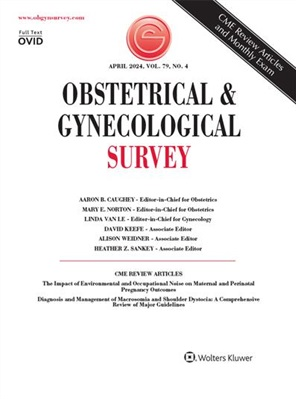妊娠期神经皮肤疾病
IF 3.6
4区 医学
Q1 OBSTETRICS & GYNECOLOGY
引用次数: 0
摘要
重要性:神经皮肤疾病对妊娠患者的护理具有重要意义。由于神经皮肤疾病是罕见的,产科医生可能不熟悉这些疾病,并建议适当的护理这一人群。目的对神经皮肤疾病与妊娠相互作用的文献进行综述,为临床护理提供参考。对PubMed、MEDLINE和Google Scholar进行了广泛的医学主题搜索(MeSH),包括“怀孕”、“Sturge -Weber”、“1型神经纤维瘤病”、“2型神经纤维瘤病”、“von Hippel Lindau”、“结节性硬化症”、“神经皮肤病”、“治疗”、“先天性畸形”、“神经发育缺陷”、“流产”、“母乳喂养”、“自身免疫”、“病理生理学”和“管理”。检索纳入文章的参考文献,以确定使用上述方法后可能遗漏的任何文章。结果神经皮肤疾病与妊娠相关的孕产妇和胎儿/新生儿发病率增加有关,主要围绕高血压疾病、癫痫和药物暴露。神经皮肤疾病的某些特征可能因怀孕而恶化或加速。神经皮肤疾病通常可以在产前诊断出来。因此,对于有神经皮肤疾病的个人或家族病史的患者,应进行定向评估。结论及意义受神经皮肤疾病影响的孕妇或计划将来怀孕的患者应由包括母胎医学、神经病学、麻醉以及其他相关专科医生在内的多学科团队密切随访。关于这些患者的最佳咨询和管理需要进一步的研究。目标受众:妇产科医生、家庭医生。完成本活动后,学习者将能够更好地识别生殖妇女中最常见的神经皮肤疾病及其对妊娠的影响;提出遗传评估、诊断、管理和鉴别诊断的建议;描述治疗方案,包括劳动和分娩管理,强调多学科方法;并讨论与神经皮肤疾病相关的潜在母体和胎儿不良后果。本文章由计算机程序翻译,如有差异,请以英文原文为准。
Neurocutaneous Disorders in Pregnancy
Importance Neurocutaneous disorders have significant implications for care of the pregnant patient. As neurocutaneous disorders are uncommon, obstetricians may be unfamiliar with these disorders and with recommendations for appropriate care of this population. Objective This review aims to summarize existing literature on the interaction between neurocutaneous disorders and pregnancy and to provide a guide for physicians caring for an affected patient. Evidence Acquisition A PubMed, MEDLINE, and Google Scholar search was carried out with a broad range of combinations of the medical subject headings (MeSH) terms “pregnancy,” “Sturge -Weber,” “Neurofibromatosis Type 1,” “neurofibromatosis type 2,” “von Hippel Lindau,” “Tuberous Sclerosis,” “neurocutaneous disorder,” “treatment,” “congenital malformations,” “neurodevelopmental defects,” “miscarriage,” “breastfeeding,” “autoimmune,” “pathophysiology,” and “management.” References of included articles were searched to identify any articles that may have been missed after the above method was used. Results Neurocutaneous disorders are associated with increased pregnancy-associated maternal and fetal/neonatal morbidity, largely surrounding hypertensive disorders, epilepsy, and medication exposure. Some features of neurocutaneous disorders may be worsened or accelerated by pregnancy. Neurocutaneous disorders can often be diagnosed prenatally. Therefore, directed assessment should be offered to affected individuals with a personal or family history of a neurocutaneous disorder. Conclusion and Relevance Patients affected by neurocutaneous disorders who are pregnant or planning for future pregnancy should be carefully followed by a multidisciplinary team, which could include maternal-fetal medicine, neurology, and anesthesia, as well as other relevant subspecialists. Additional research is required regarding optimal counseling and management of these patients. Target Audience Obstetricians and gynecologists, family physician. Learning objectives After completing this activity, the learner will be better able to identify the most common neurocutaneous disorders seen in reproductive women and their implications in pregnancy; propose recommendations for genetic evaluation, diagnosis, management, and a differential diagnosis; describe treatment options including labor and delivery management, emphasizing multidisciplinary approach; and discuss potential maternal and fetal adverse outcomes related to neurocutaneous disorders.
求助全文
通过发布文献求助,成功后即可免费获取论文全文。
去求助
来源期刊
CiteScore
2.70
自引率
3.20%
发文量
245
审稿时长
>12 weeks
期刊介绍:
Each monthly issue of Obstetrical & Gynecological Survey presents summaries of the most timely and clinically relevant research being published worldwide. These concise, easy-to-read summaries provide expert insight into how to apply the latest research to patient care. The accompanying editorial commentary puts the studies into perspective and supplies authoritative guidance. The result is a valuable, time-saving resource for busy clinicians.

 求助内容:
求助内容: 应助结果提醒方式:
应助结果提醒方式:


